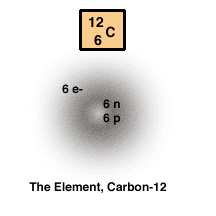| |
Isotopes and Ions
Atoms that have the same number of protons, (Z), as an element but with
a larger number of neutrons than the element has are called
isotopes . Since neutrons are as massive as protons,
the mass of an atom and its isotope(s) is(are) different. The atomic notations
for the elemental form of carbon and its isotope C-14, (a carbon atom with
8 neutrons and 6 protons), are shown below. Isotopes are generally
less stable than the atoms of their corresponding element. As a result,
the nuclei of isotopes can undergo spontaneous radioactive decay in
an effort to stabilize the atom. The decay process is accompanied by the
release of high energy electromagnetic radiation like X-rays, and in some
cases, by the ejection of sub-atomic particles such as electrons, protons,
and neutrons. When the particle or particles ejected are protons,
the isotope becomes a different element with a smaller number of protons. This process is called
transmutation
 
Most chemical reactions take place when the electrons associated with different atoms that
are in close proximity to each other begin to interact. Electrons that
are farthest from the positively charged nucleus are the most likely to
be involved in chemical reactions, and are referred to as
valence electrons. In some case valence electrons can be pulled
away from an atom by the strong attractive force coming from a nearby atom.
The remaining altered atom now has one fewer electron than the neutral
element, and so has a net positive charge. In fact, it is no longer an
atom but rather, it is called an ion.
Ions with extra electrons can also form resulting in a net negative
charge on the ion. Positively charged ions are also called
cations,
while negatively charged ions are called anions.
|
Report technical/Content problems here
|
|

